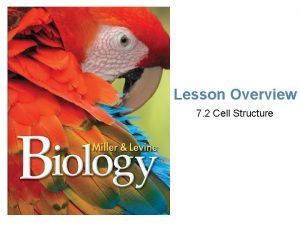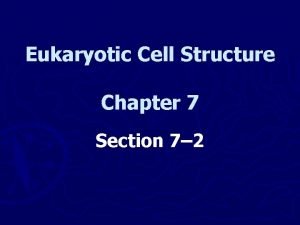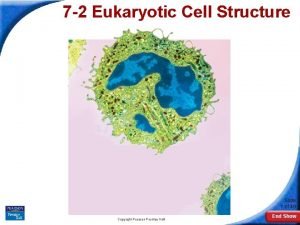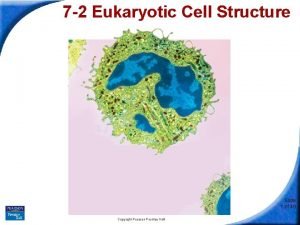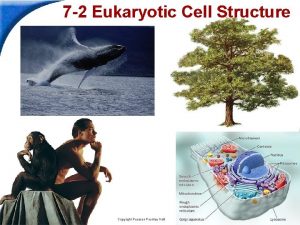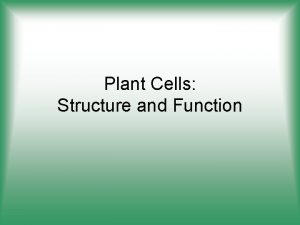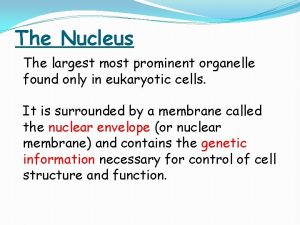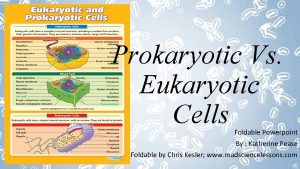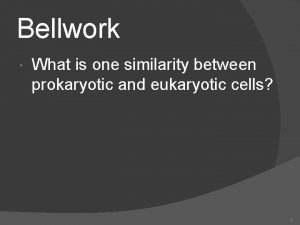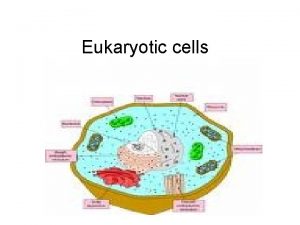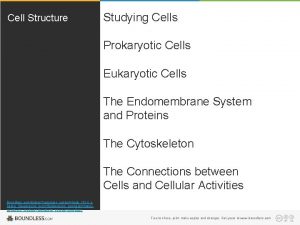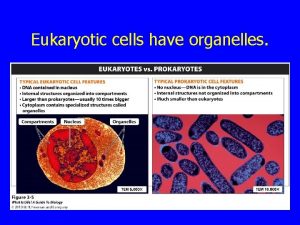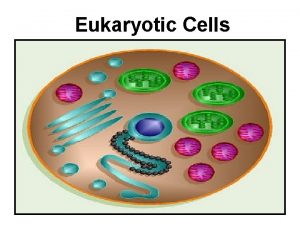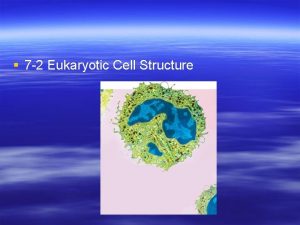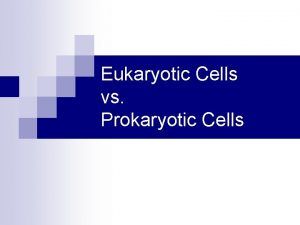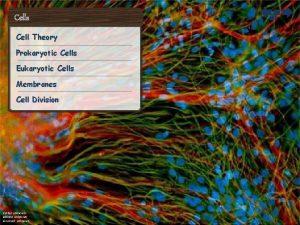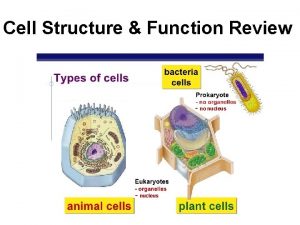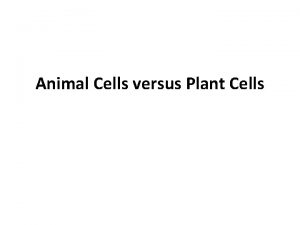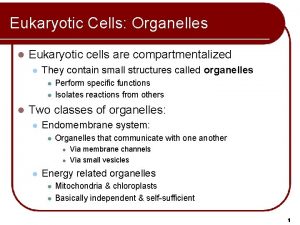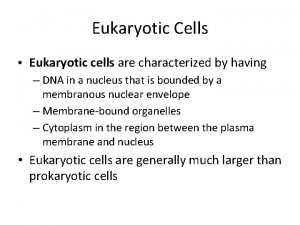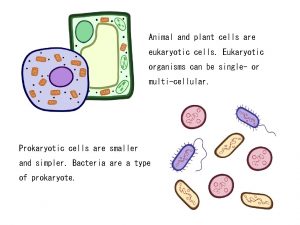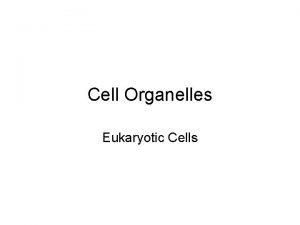Cell Structure Review Eukaryotic Cells Have a nucleus




















- Slides: 20

Cell Structure Review

Eukaryotic Cells • • Have a nucleus Found in multi-cellular organisms & some unicellular organisms

Prokaryotic Cells • • Do not have a nucleus Found in bacteria

Cell Membrane • • Thin, flexible layer Separates the cell from its surrounding environment Controls movement of materials into and out of the cell Helps maintain the cell’s internal environment

Cell Wall ¢ Cell walls, found in plant cells, are much stronger than cell membranes and protect cells from lysing (exploding) in extremely hypotonic (diluted) solutions.

Nucleus • • • Control center of the cell Manages all of the cell’s activities Largest organelle Contains the genetic material (chromatin) the cell needs to reproduce and function. Is surrounded by the nuclear envelope and also contains the nucleolus and chromatin.

Chromatin • • • Coils of DNA and protein that form chromosomes. Can be thought of as chromosomes without shape. Granular-like material found in the nucleus containing genetic information

Chromosome ¢ • • Worm-like / rodlike structures formed from chromatin during cell reproduction. They become distinct during the reproductive part of the cell cycle as the cell divides. Composed of DNA

Mitochondria ¢ • • • Organelles that cause the release of energy by using oxygen to break down sugars. Usually round or tube shaped Releases food molecules that supply energy to the cell; it is known as the powerhouse of the cell. Usually more than one in a cell

Cytoplasm • • • Thick, jelly-like substance contained within the cell membrane Most of the work of the cell is carried out here. The majority of the organelles are suspended in the cytoplasm.

DNA • • • The genetic material found in all living cells. Contains the information needed for an organism to grow, maintain itself, and reproduce Stands for deoxyribonucleic acid

Endoplasmic Reticulum • • Network of channels/tubes leading from the nuclear membrane into the cytoplasm Helps transport materials between the nucleus and the cytoplasm Also involved in transporting proteins Two types: - Smooth E. R. = no ribosomes -Rough E. R. = contains ribosomes

Lysosomes ¢ • • Sac-like structures that contain enzymes Where digestion of cell nutrients & food molecules take place Breaks down cellular waste or things that are harmful to the cell • Similar to the job of white blood cells

Centriole ¢ Centrioles are roughly tubular in shape, and they play an important role in cell division. The centrioles are found in pairs and move towards the poles (opposite ends) of the nucleus when it is time for cell division.

Chloroplast ¢ Chloroplasts are organelles found only in plant cells. Chloroplasts are the site of photosynthesis, a process in which the plant uses carbon dioxide, water and sunlight to create energy in the form of glucose for the plant.

Vacuole ¢ Think of these membrane sacs that have a variety of functions as containment units. They can hold many substances from organic molecules to simple excess water. Plant cells have a central vacuole that is important in maintaining plant turgidity.

Golgi Bodies ¢ • • • Serve as storage and packaging centers. Look like stacks of flattened sacs Proteins made by the ribosomes are packaged into vesicles (small pockets) These packages are used by the cell and sometimes are released from it.

Nuclear Envelope • • Has a double-layered membrane that separates the nucleus from the cytoplasm. Contains pores to help facilitate the exchange of materials between the nucleus and the cytoplasm

Ribosomes • • Sites of protein manufacturing in the cell Assemble proteins that: • • • Create chemical messages to run a cell. Build cell organelles Line the membrane of the rough endoplasmic reticulum & are found in the cytoplasm

Nucleolus ¢ The prominent structure in the nucleus is the nucleolus. The nucleolus produces ribosomes, which move out of the nucleus to positions on the rough endoplasmic reticulum where they are critical in protein synthesis.
 Eukaryote examples
Eukaryote examples Prokaryotic cells
Prokaryotic cells Cuál es la diferencia entre la célula animal y vegetal
Cuál es la diferencia entre la célula animal y vegetal Prokaryotic vs eukaryotic cells
Prokaryotic vs eukaryotic cells Which blood cells have a nucleus
Which blood cells have a nucleus Site:slidetodoc.com
Site:slidetodoc.com Prokaryotic cell and eukaryotic cell similarities
Prokaryotic cell and eukaryotic cell similarities Life
Life Eukaryotic cell animal cell
Eukaryotic cell animal cell Cell structure
Cell structure Saclike structure that stores materials
Saclike structure that stores materials Biology chapter 7 cell structure and function
Biology chapter 7 cell structure and function Eukaryotic cell
Eukaryotic cell Section 7-2 eukaryotic cell structure
Section 7-2 eukaryotic cell structure Section 7-2 eukaryotic cell structure
Section 7-2 eukaryotic cell structure Eukaryotic plant cell
Eukaryotic plant cell Most prominent organelle in eukaryotic cells
Most prominent organelle in eukaryotic cells Eukaryotic cells
Eukaryotic cells 3 parts of cell theory
3 parts of cell theory Is protist a prokaryote or eukaryote
Is protist a prokaryote or eukaryote Similarity between prokaryotic and eukaryotic cells
Similarity between prokaryotic and eukaryotic cells









